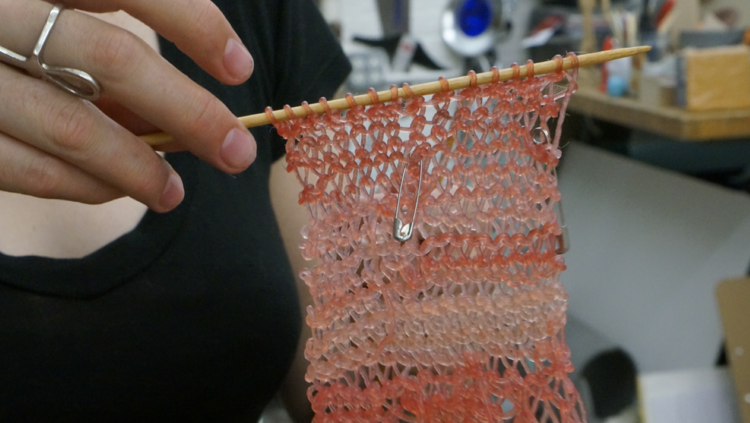An endless supply of yarn produced by a colony of bacteria. A blockchain-powered ledger that tells you exactly how your clothes came to be. Beautiful fabric that comes straight out of a 3D printer.
These are just some of the ideas brewing at Pratt Institute‘s Brooklyn Fashion + Design Accelerator (BF+DA). Housed in the Pfizer Building — which has also attracted a plethora of food-tech startups such as urban-farming accelerator Square Roots and aquaponics farm VertiCulture — the BF+DA serves as a laboratory of sorts for innovations such as 3D knitting and sustainable fabrics, as well as a space for fashion and design entrepreneurs. This week, the accelerator announced that it has been selected to receive a $486,000 research grant from the U.S. Department of Commerce.
Since its opening in the fall of 2014, the accelerator has incubated some 35 fashion and design startups through its venture fellowship program. According to Pratt, those companies collectively bring in more than $20 million in sales each year, and the accelerator has helped boost their revenues by 78 percent. Now the BF+DA is looking to bolster its ability to assist those working on more experimental concepts. The Department of Commerce grant will go toward enhancing its research fellowship program, Deb Johnson, the BF+DA’s director, told Technical.ly. Applications for the program will open next year.
Through its revamped research fellowship program, the BF+DA is seeking to explore ways in which technology can support sustainability, transparency — knowing the complete production cycle of a garment — and ethical production. Several of its past research fellows have explored alternative modes of fabric production. For instance, past research fellow Gian Cui was a member of the team at the Fashion Institute of Technology that developed Bioesters, yarn made from extruded bacteria and fungi. Bioesters won this summer’s Biodesign Challenge, organized by Brooklyn community lab Genspace. Another past research fellow, Francis Bitonti, has gained renown for his work in 3D-printed fashion, including making a gown for burlesque dancer Dita von Teese.
The accelerator’s goal, Johnson said, is to turn these futuristic concepts into solid business ventures. The grant will subsidize the fellows’ production work in the accelerator space and allow the program to bring on additional mentors to guide the fellows.
“We’re super-excited,” she said. “It’s a small step into a very large world, to be able to focus on these young hackers, makers, scientists, designers — these people who are a little bit like Leonardo da Vincis.”
Johnson said she’s especially interested in the possible application of blockchain technology to the fashion industry. As issues such as fair wages and humane working conditions for overseas workers have become more visible, more and more consumers have become curious about how their clothes are made. But in many cases, gathering that information is difficult, Johnson said. Especially overseas, many factories’ outsourcing partners aren’t clearly documented. The idea is that blockchain could be a painless tool to track every phase of production, from the farm that grew the cotton used to make a shirt to the factory where its buttons were sewed on.
There is one hitch, though, she recognizes.
“The question is, ‘How are you going to incentivize companies so that the reporting gets done?'” she said.
In addition to supporting emerging technology, the BF+DA also works with established fashion companies. Its production studio includes 3D-knitting machines, which can complete an entire sweater in 30 minutes. Its cut-and-sew department offers small-run production services to designers. The accelerator also hosts the s.Lab, a resource center for sustainability, which is run by Carolyn Shafer, the director of Pratt’s Center for Sustainable Design Strategies. The s.Lab includes a fabric library and will soon launch a website where designers can research and collaborate on sustainability strategies.
Shafer guided Technical.ly through the fabric resource center, which includes blurbs on a given fabric’s environmental impact over its life cycle. A few of the fabrics are largely conceptual, for now. Take Fabrican, for instance: a liquid fabric that is sprayed onto the body and solidifies once it’s exposed to the air. (Aerosol couture, anyone?)
But Shafer is also concerned with what happens to garments after they’re purchased. Many companies and designers overlook environmental impact after production, she said.
Johnson said she hopes that by serving companies at all stages, the BF+DA will become a go-to knowledge source for the fashion industry. The grant, she said, will help propel the accelerator toward that goal by bringing in additional research and science expertise.
“My dream is to be able to stand in the middle of the room, ask a question and get an answer from multiple perspectives: the manufacturing side, the science side, the social sciences side, the business side,” she said. “Just a swarm of expertise around a particular question.”







